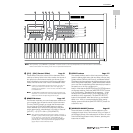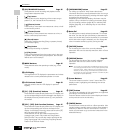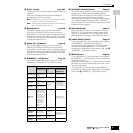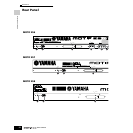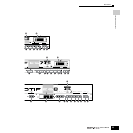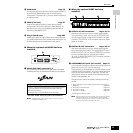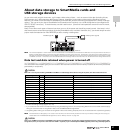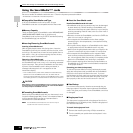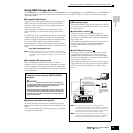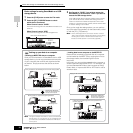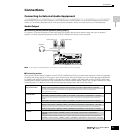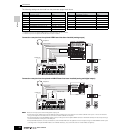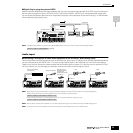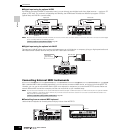
Setting Up
About data storage to SmartMedia cards and USB storage devices
27
Owner’s Manual
About data storage to SmartMedia cards and
USB storage devices
As you make music with this instrument, you’ll create a wide variety of data — such as custom Voice data (including Voices,
Performances, etc.), MIDI sequence data (Songs, Patterns, Arpeggios), and waveform data (with the Sampling function).
Naturally, you’ll want to store this data for safekeeping and future use, and the instrument is equipped with a variety of storage
options. You can save your data to SmartMedia card (inserted to the Card slot) or to a USB storage device (connected to the
USB TO DEVICE connector). To recall the data, use the Load function. (Save and Load operations are done in the File mode;
see page 266.)
Keep in mind that certain types of data are lost when you turn off the power and should be properly saved. Also keep in mind
that since there are several storage options (including SmartMedia card, hard disk, flash disk, etc.), you should always have the
proper media formatted and on hand BEFORE you start creating or editing data.
n The Save/Load operation in the File mode can be executed between the SmartMedia card inserted to the CARD slot on the rear panel and the instrument, or
between the USB storage device connected to the USB TO DEVICE connector and the instrument. Please keep in mind that the Save /Load operation in the
File mode cannot be executed between the SmartMedia card inserted to the CARD slot on the rear panel and the USB storage device connected to the USB
TO DEVICE connector. In short, data can be saved/loaded between the storage media and the instrument, but not between the two storage media devices.
Data lost and data retained when power is turned off
The chart below lists the data types you can create on the instrument and the internal memory locations to which they are stored,
permanently or temporarily.
Make sure to save any data remaining in DRAM to SmartMedia or a USB storage device before turning off the power, other wise the data will be lost.
* Includes the Mixing settings (pages 103, 127)
** If you create the User Voices or Sample Voices by using the Sampling function, the corresponding Waveforms can be saved automatically by
saving the User Voice data or Song/Pattern data to the SmartMedia/USB storage device.
***
Song Mixing/Pattern Mixing can be stored as Song/Pattern data and as a Mixing Template (which are not associated with a specific Song/Pattern).
n For details about the data types you can create on this instrument, the internal memory locations to which they are stored, and file types when saving the
created data to the SmartMedia/USB storage device, refer to “Memory Structure” on page 186.
Data of up to 128 MB can be saved to a SmartMedia card inserted to the CARD slot on the rear panel. Yamaha recommends the use of a large-capacity USB
storage device, since you may want to save data more 128 MB — especially if you’ve installed optional DIMMs (page 289) and are using the Sampling feature.
Data types Page Mode in which data is created Internal memory types to which data is stored
Voice 79 Voice mode Flash ROM
Mixing Voice 105 Mixing Voice mode DRAM ➜ Will be lost when turning the power off!
Performance 87 Performance mode Flash ROM
Song* 117 Song mode DRAM ➜ Will be lost when turning the power off!
Song Chain 59 Song Chain mode DRAM ➜ Will be lost when turning the power off!
Pattern* 106 Pattern mode DRAM ➜ Will be lost when turning the power off!
Pattern Chain 115 Pattern Chain mode DRAM ➜ Will be lost when turning the power off!
Phrase (Pattern) 110 Pattern mode DRAM ➜ Will be lost when turning the power off!
Arpeggio 130 Song mode, Pattern mode Flash ROM
Master 136 Master mode Flash ROM
Waveform** 94 Sampling mode DIMM (DRAM) ➜ Will be lost when turning the power off!
Mixing Template*** 103 Song Mixing mode, Pattern Mixing mode Flash ROM
System settings 185 Utility mode Flash ROM
MUSIC PRODUCTION SYNTHESIZER
MOTIF ES
SmartMedia (page 28)
USB TO DEVICE connector
USB storage device (page 29)
CAUTION
CAUTION



